Study on Shear Behavior and Failure Characteristics of Bolted Anisotropic Rock Joints
Abstract
:1. Introduction
2. Laboratory Direct Shear Test
2.1. Specimen Preparation
2.2. Testing Equipment
3. Test Results and Analysis
3.1. Shear Stress–Shear Displacement Analysis
3.2. Analysis of Shear Strength Characteristics
3.3. Analysis of Shear Failure Characteristics of Rock Joint
3.4. Shear Deformation Fracture Characteristics of Bolt
3.5. Deformation Analysis of Shear Bolt Mechanical Model
3.6. Analysis of Fracture Shear Displacement Characteristics of Bolt
4. Conclusions
- (1)
- The shear stress–shear displacement curve of the bolted anisotropic rock joint can be divided into four stages: initial linear elastic stage, bolt breaking stage, bolt breaking stage and residual strength stage. In the initial linear elastic stage, the shear stress increases approximately linearly with the increase in shear displacement. The shear stress shows a different trend with the increase in shear displacement under different normal stress. In the rock bolt breaking stage, the rock bolt breaks when it reaches the bending limit, and the stress drops on the curve. In the residual strength stage, the shear strength in this stage is the same or slightly higher than that in the unanchored state.
- (2)
- The shear strength of bolted anisotropic rock joint and non-bolted anisotropic rock joint conforms to Mohr–Coulomb strength criterion. The shear strength of the rock joint is enhanced by increasing the cohesion and internal friction angle of the rock joint. With the increase in λ value, the slope of the curve of the bolted anisotropic rock joint decreases obviously. It can be seen that the larger the λ value is, the smaller the friction angle of the bolted anisotropic rock joint is. Under the same normal stress condition, the peak shear strength decreases with increasing λ value. This indicates that the greater the strength difference between the two sides of the rock joint, the worse the shear capacity of the rock joint.
- (3)
- The elliptic failure occurs on the surface of the rock joint, and the length of the major axis of the ellipse decreases with the increase in λ value and normal stress. On the one hand, the cause of elliptical failure is that the bolt compresses the pore wall in the shear process, resulting in the extrusion destruction of the anchoring agent and rock mass at the rock joint. The residual pink anchoring agent powder on the surface of the footwall coal pore wall also verifies this reason. On the other hand, the shear process continues after the breaking of the bolt, and the protruding bolt of the rock joint continues to slide along with the shear process. In the sliding process, the rock on the hanging wall continues to be damaged until the second failure of the bolt or the end of the shear occurs. However, compared with the failure reasons mentioned in the former, the latter causes a lower degree of damage.
- (4)
- The bolts with different λ values show the deformation characteristics of the “Z” shape after a shear fracture. At the same time, the deformation range of the bolts on both sides of the rock joint is not the same because of the different strengths of the rock in the upper and footwall. The horizontal and vertical components of bolt deformation decrease with the increase in λ value and normal stress, and the same conclusion is obtained by theoretical analysis.
- (5)
- The breaking shear displacement of the bolt increases with the increase in normal stress and decreases with the increase in λ value. When λ = 2.35, 3.78, 4.16 and 6.72, the breaking shear displacement of the bolt is 2.73, 5.5, 5.38 and 5.18 mm, respectively. This is because the footwall coal remains unchanged, the strength of the hanging wall rock gradually increases, and the ultimate compressive force of the hanging wall anchor bolt increases when bending, resulting in the transverse shear force of the anchor bolt increasing. Moreover, the axial force decreases correspondingly because the bending yield strength of the anchor bolt has been reached under the small shear displacement, and then the breaking occurs.
Author Contributions
Funding
Institutional Review Board Statement
Informed Consent Statement
Data Availability Statement
Conflicts of Interest
References
- Ban, L.R.; Qi, C.Z.; Shan, R.L.; Tao, Z.G.; Xia, C.; Jiang, K. Pre-peak shear constitutive model considering the softening shear stiffness and its influencing factors. J. China Coal Soc. 2018, 43, 2765–2772. [Google Scholar]
- Wang, C.S.; Liu, R.C.; Jiang, Y.J.; Wang, G.; Luan, H.J. Effect of shear-induced contact area and aperture variations on nonlinear flow behaviors in fractal rock fractures. J. Rock Mech. Geotech. Eng. 2022, 15, 309–322. [Google Scholar] [CrossRef]
- Yang, T.H.; Wang, P.T.; Xu, T.; Yu, Q.L.; Zhang, P.H.; Shi, W.H.; Hu, G.J. Anisotropic characteristics of jointed rock mass: A case study at Shirengou iron ore mine in China. Tunn. Undergr. Space Technol. 2015, 48, 129–139. [Google Scholar] [CrossRef]
- Liu, X.R.; Xu, B.; Zhou, X.H.; Yi, L.; Zeng, X.; Wang, J.W. Investigation on the macro-meso shear mechanical properties of soft-hard interbedded rock discontinuity. J. China Coal Soc. 2021, 46, 2895–2909. [Google Scholar]
- Luan, H.J.; Cao, Y.W.; Jiang, Y.J.; Guan, Y.T.; Li, C.P.; Zhang, S.H.; Liu, J.R. Implementation of tension-shear coupling failure mode of rock bolts in FLAC3D and its application. J. Min. Strat. Control Eng. 2022, 4, 5–15. [Google Scholar]
- Wang, Y.Y.; Gong, B.; Zhang, Y.J.; Yang, X.Y.; Tang, C.A. Progressive fracture behavior and acoustic emission release of CJBs affected by joint distance ratio. Mathematics 2022, 10, 4149. [Google Scholar] [CrossRef]
- Gong, B.; Wang, Y.Y.; Zhao, T.; Tang, C.A.; Yang, X.Y.; Chen, T.T. AE energy evolution during CJB fracture affected by rock heterogeneity and column irregularity under lateral pressure. Geomat. Nat. Hazards Risk 2022, 13, 877–907. [Google Scholar] [CrossRef]
- Wang, Y.Y.; Gong, B.; Tang, C.A. Numerical investigation on anisotropy and shape effect of mechanical properties of columnar jointed basalts containing transverse joints. Rock Mech. Rock Eng. 2022, 55, 7191–7222. [Google Scholar] [CrossRef]
- Tao, Z.G.; Ren, S.L.; He, M.C.; Xia, M. Static tensile and bolting shear mechanical properties of micro-NPR bolt steel in underground engineering. J. China Coal Soc. 2022, 47, 683–694. [Google Scholar]
- Cheng, G.T.; Liu, C.X.; Zhang, J.; Zhang, N.; Cui, G.J. Shear behaviour of reproduced rough and bolted marble joints using the 3D carving technique. Arab. J. Geosci. 2022, 15, 905. [Google Scholar] [CrossRef]
- He, M.C.; Ren, S.L.; Guo, L.J.; Lin, W.J.; Zhang, T.W.; Tao, Z.G. Experimental study on influence of host rock strength on shear performance of micro-npr steel bolted rock joints. Int. J. Rock Mech. Min. 2022, 159, 105236. [Google Scholar] [CrossRef]
- Jiang, Y.J.; Zhang, S.H.; Luan, H.J.; Chen, L.J.; Zhang, G.C.; Wang, C.S. Numerical Investigation on the Effect of Cyclic Loading on Macro-meso Shear Characteristics of Rock Joints. J. China Coal Soc. 2021, 48, 199–211. [Google Scholar]
- Jiang, Y.J.; Zhang, S.H.; Luan, H.J.; Wang, C.S.; Wen, Z.J.; Wang, D.; Han, W. Experimental study on shear characteristics of bolted rock joints under constant normal stiffness boundary conditions. Chin. J. Rock Mech. Eng. 2021, 40, 663–675. [Google Scholar]
- Srivastava, L.P.; Singh, M. Effect of fully grouted passive bolts on joint shear strength parameters in a blocky mass. Rock Mech. Rock Eng. 2015, 48, 1197–1206. [Google Scholar] [CrossRef]
- Wang, G.; Zhang, Y.Z.; Jiang, Y.J.; Liu, P.X.; Guo, Y.S.; Liu, J.K.; Ma, M.; Wang, K.; Wang, S.G. Shear Behaviour and Acoustic Emission Characteristics of Bolted Rock Joints with Different Roughnesses. Rock Mech. Rock Eng. 2018, 51, 1885–1906. [Google Scholar] [CrossRef]
- Zheng, L.B.; Wang, L.Q.; Zhu, L.F.; Jiang, Y.F.; Wang, B. Experimental study on the effect of locking mode on shear characteristics of bolted rock joint. Rock Soil Mech. 2021, 42, 1056–1064. [Google Scholar]
- Spang, K.; Egger, P. Action of fully-grouted bolts in jointed rock and factors of influence. Rock Mech. Rock Eng. 1990, 23, 201–229. [Google Scholar] [CrossRef]
- Liu, S.G.; Huang, Z.X.; Zhang, H. Study of Shearing Tests of Bolted Frictionless Joints with Different Anchorage Angles. Chin. J. Undergr. Space Eng. 2022, 18, 824–831. [Google Scholar] [CrossRef]
- Zhang, Y.H.; Wang, D.J.; Tang, H.M.; Li, C.D.; Yi, X.L. Study of shear strength characteristics of heterogeneous discontinuities using PFC2D simulation. Rock Soil Mech. 2016, 37, 1031–1041. [Google Scholar]
- Yang, B.Y.; Xiao, M.; Luo, N.; Wang, X.W. Research on mechanical characteristic of anchor bolt in process of shearing. J. Huazhong Univ. Sci Tech. 2019, 47, 127–132. [Google Scholar]
- He, J.M.; Wu, G. The criterion tor shear strength of discontinuties with different rock properties in rock mass. J. Chongqing Univ. 1994, 17, 105–110. [Google Scholar]
- Fang, K.; Wu, Q.; Wang, J.; Tan, F.L. Research on Shear Characteristics and the Evolution Mechanism of Bedding Planes Between Two Different Rock Types Based on Particle Flow Code. J. Yangtze River Sci. Res. Inst. 2014, 31, 31–37. [Google Scholar]
- Del Greco, O.; Ferrero, A.M.; Oggeri, C. Experimental and analytical interpretation of the behaviour of laboratory tests on composite specimens. Int. J. Rock Mech. Min. Sci. 1993, 30, 1539–1543. [Google Scholar] [CrossRef]
- Cui, G.J.; Zhang, C.Q.; Liu, L.P.; Zhou, H.; Cheng, G.T. Study of effect of shear velocity on mechanical characteristics of bolt-grout interface. Rock Soil Mech. 2018, 39, 275–281. [Google Scholar]
- Chen, W.Q.; Zhao, Y.F.; Zhou, J.J. Shear resistance theory of bolt considering nonlinear behaviour of grout reaction force. Rock Soil Mech. 2018, 39, 1662–1668. [Google Scholar]
- Liu, Q.S.; Lei, G.F.; Peng, X.X.; Wei, L. Shearing mechanical model and experimental verification of bolts in jointed rock mass. Chin. J. Geotech. Eng. 2018, 40, 794–801. [Google Scholar]
- Andres, U.; Timoshkin, I.; Jirestig, J.; Stallknecht, H. Liberation of valuable inclusions in ores and slags by electrical pulses. Powder Technol. 2001, 114, 40–50. [Google Scholar] [CrossRef]
- Fukushima, K.; Kabir, M.; Kanda, K.; Obara, N.; Fukuyama, M.; Otsuki, A. Simulation of Electrical and Thermal Properties of Granite under the Application of Electrical Pulses Using Equivalent Circuit Models. Materials 2022, 15, 1039. [Google Scholar] [CrossRef]
- Zhang, W.; Liu, Q.S. Analysis of deformation characteristics of prestressed anchor bolt based on shear test. Rock Soil Mech. 2014, 35, 2231–2240. [Google Scholar]
- Ge, X.R.; Liu, J.W. Study on shear behavior of anchorage joint surface. Chin. J. Geotech. Eng. 1988, 1, 8–19. [Google Scholar]
- Liu, C.H.; Li, Y.Z. Research progress in bolting mechanism and theories of fully grouted bolts in jointed rock masses. Chin. J. Rock Mech. Eng. 2018, 37, 1856–1872. [Google Scholar]
- Ferreroq, A.M. The shear strength of reinforced rock joints. Int. J. Rock Mech. Min. Sci. Geomech. Abstr. 1995, 32, 590–600. [Google Scholar]
- Holmberg, M. The mechanical behavior of untensioned grouted rock bolts. Ph.D. Thesis, KTH Royal Institute of Technology, Stockholm, Sweden, 1991. [Google Scholar]
- Pellet, F.; Egger, P. Analytical model for the mechanical behaviour of bolted rock joints subjected to shearing. Rock Mech. Rock Eng. 1996, 29, 73–97. [Google Scholar] [CrossRef]
- Yang, S.L.; Xu, Y.W.; Huang, Q.P. Analysis on the bolt deformation as result of joint shear displacement. Chin. J. Rock Mech. Eng. 2004, 23, 3268–3273. [Google Scholar]
- Wang, L.Q.; Zhu, L.F.; Zheng, L.B.; Fan, B.Q.; Zhang, Z.H.; Chen, H.J. Shear Test of Bolted Joint Rock Masses Considering Joint Roughness. China J. Highw. Transp. 2021, 34, 38–47. [Google Scholar]
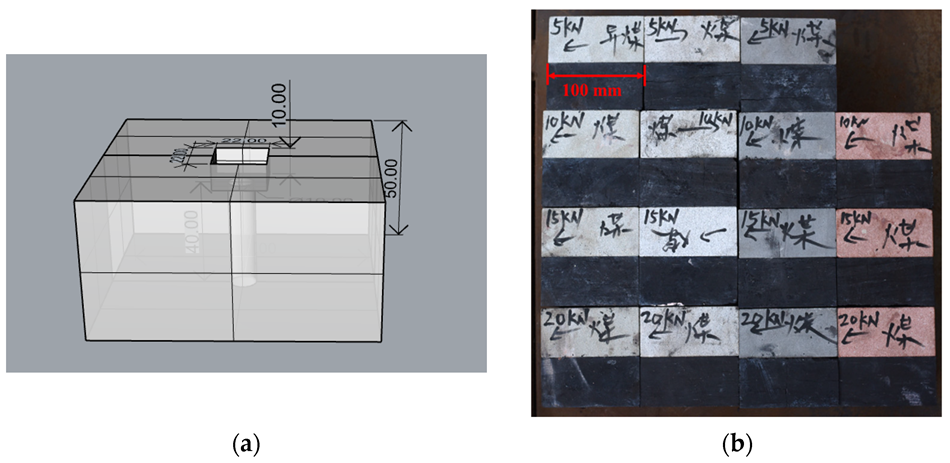
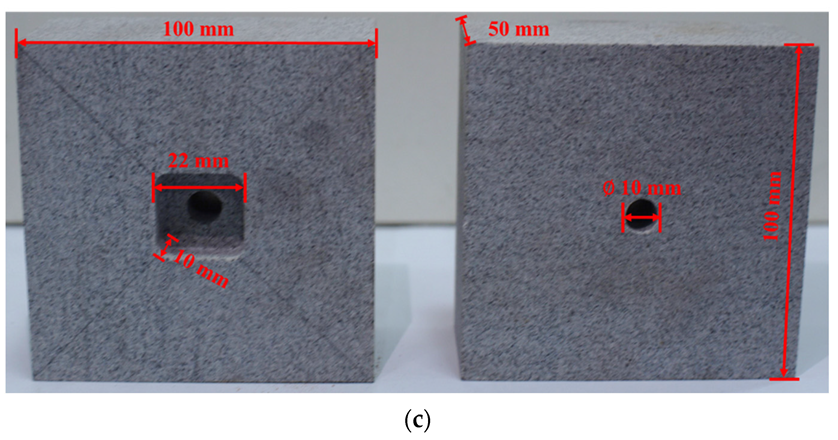
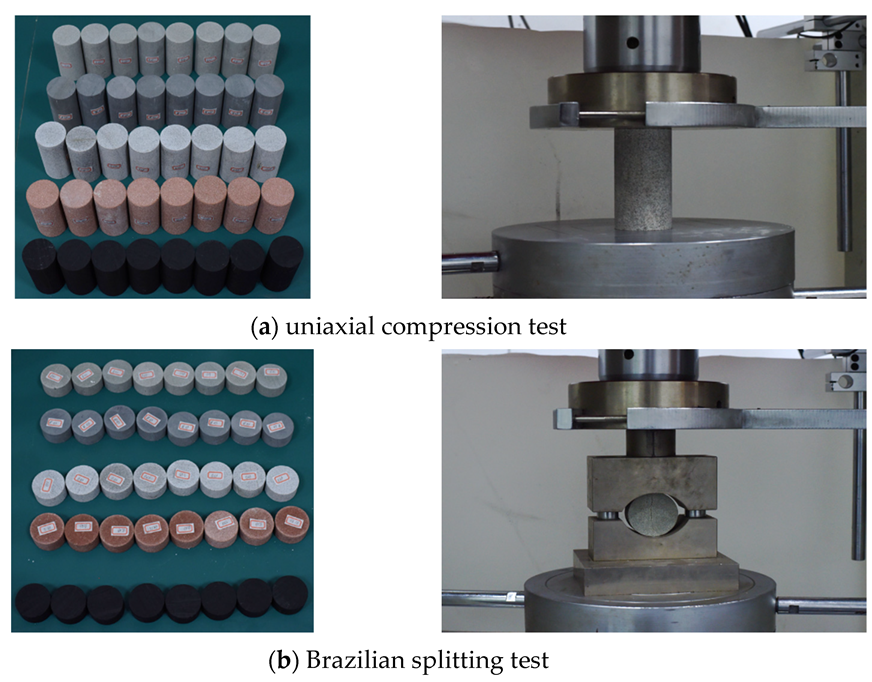
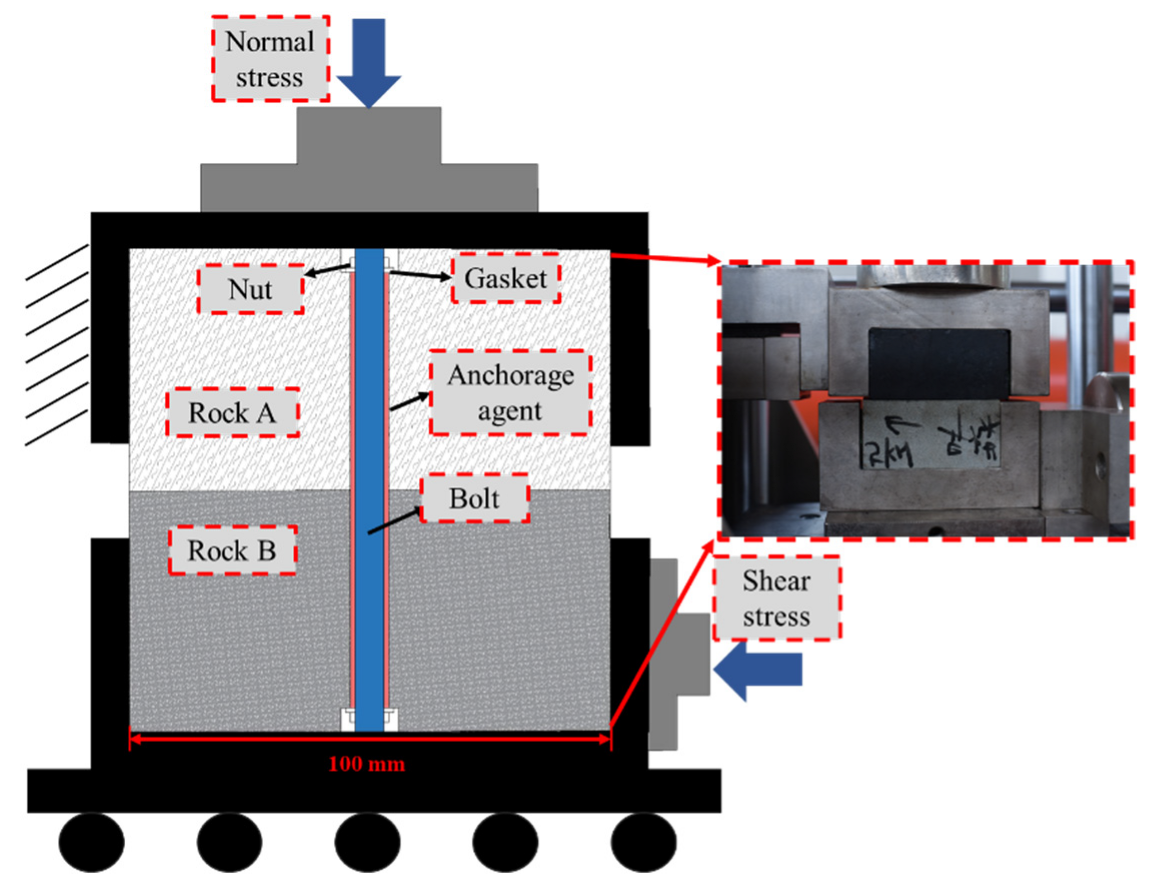

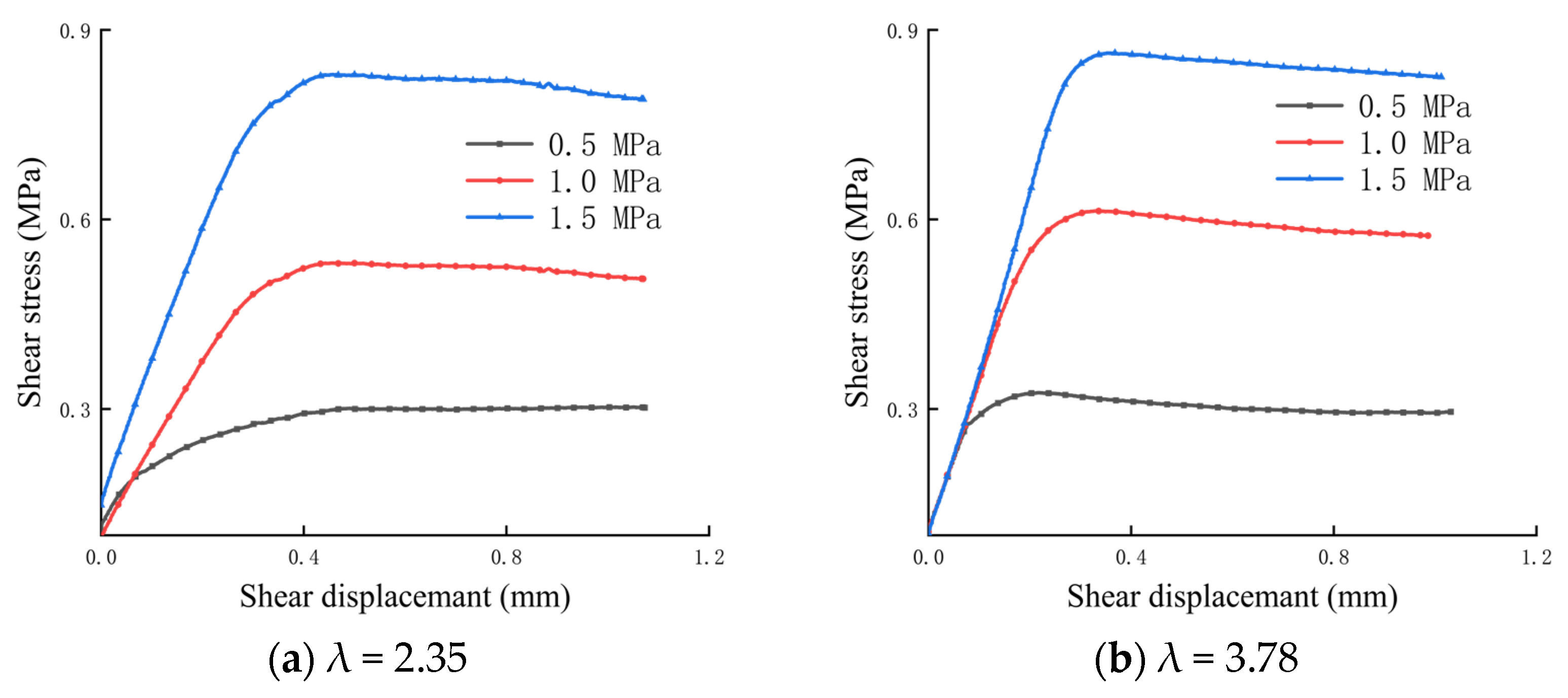
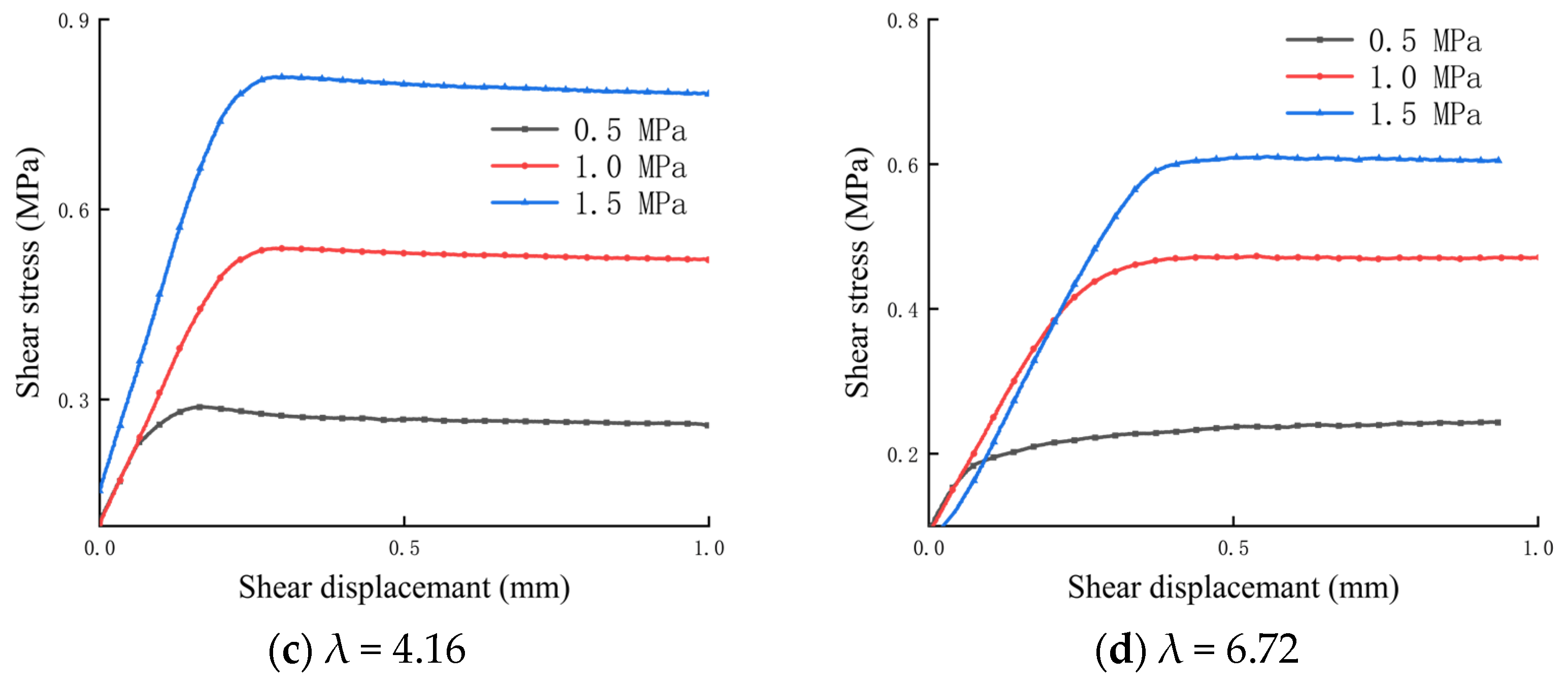
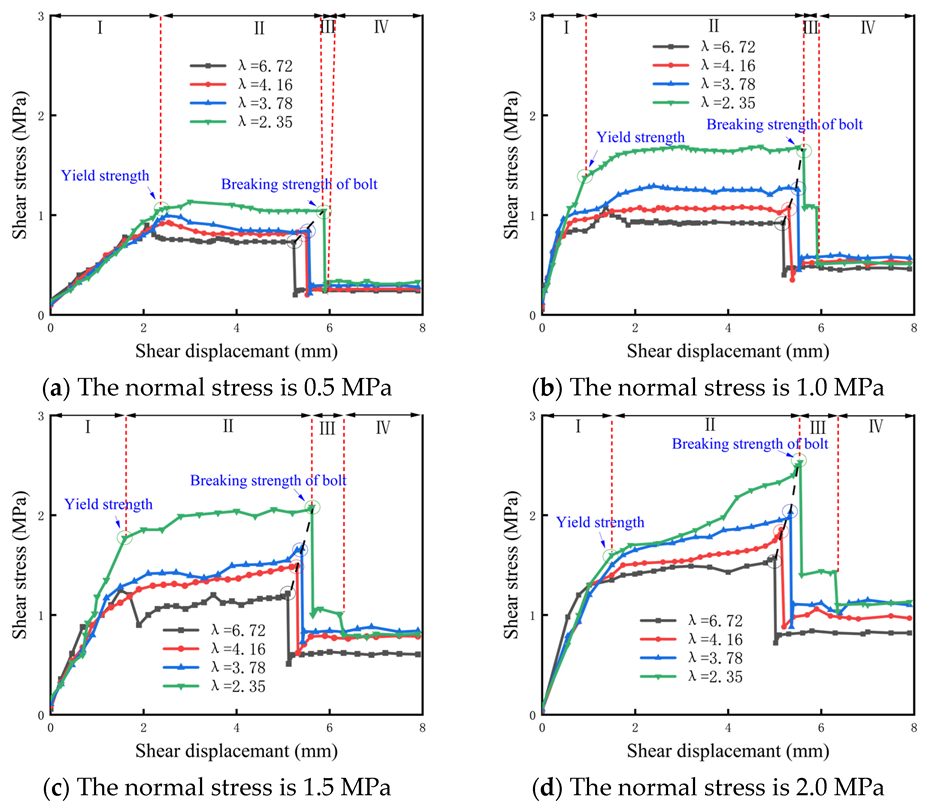
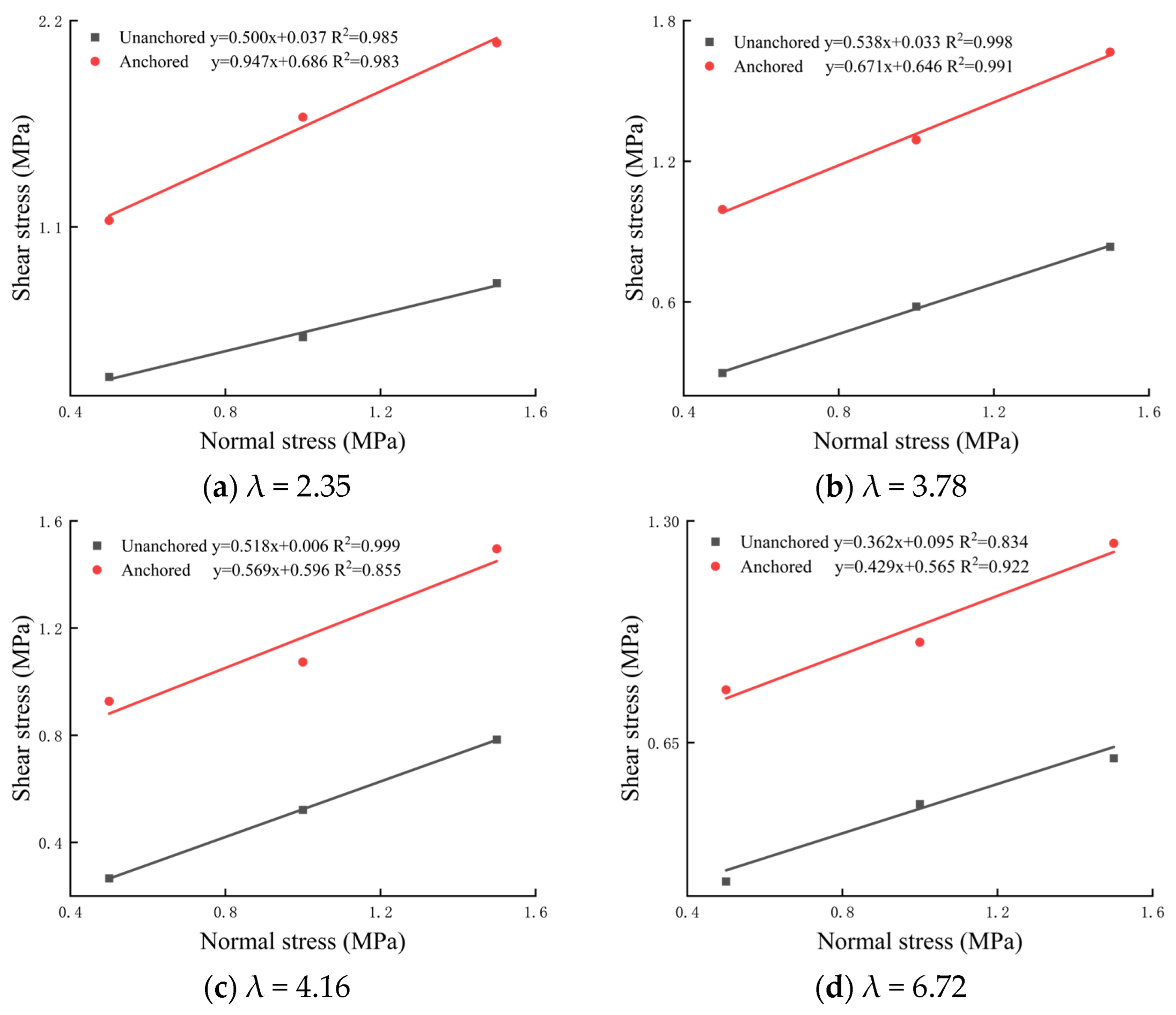
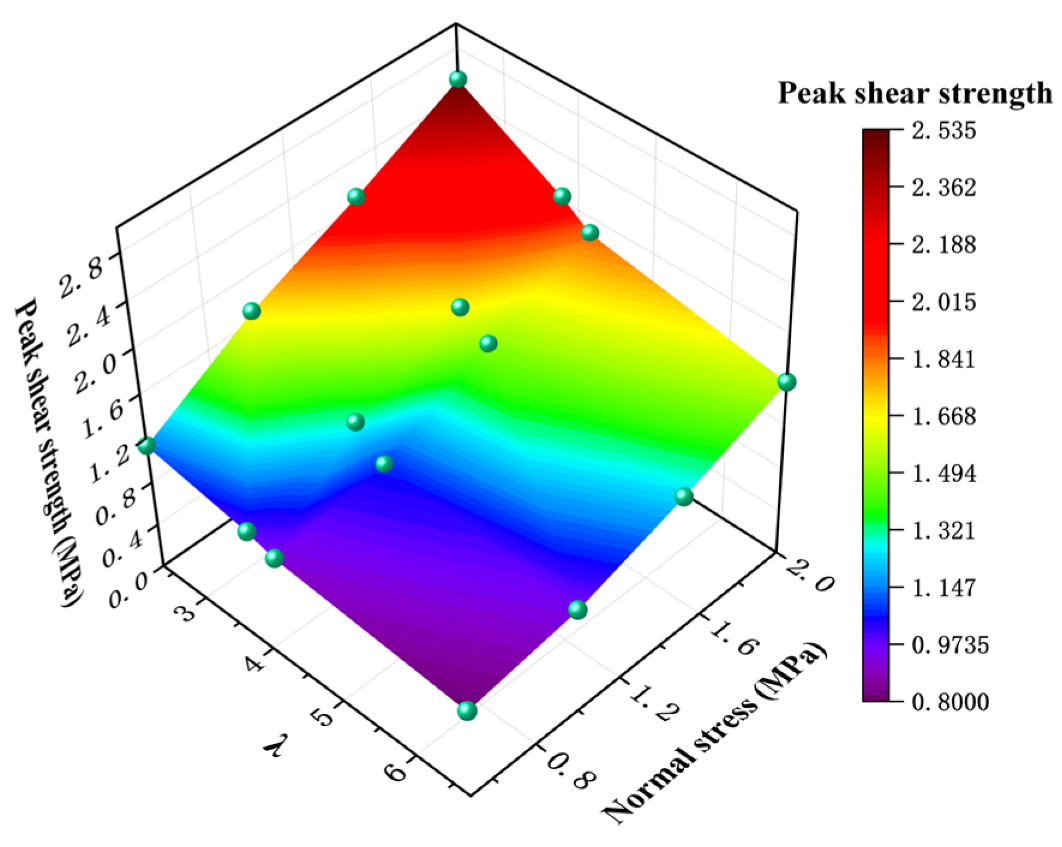


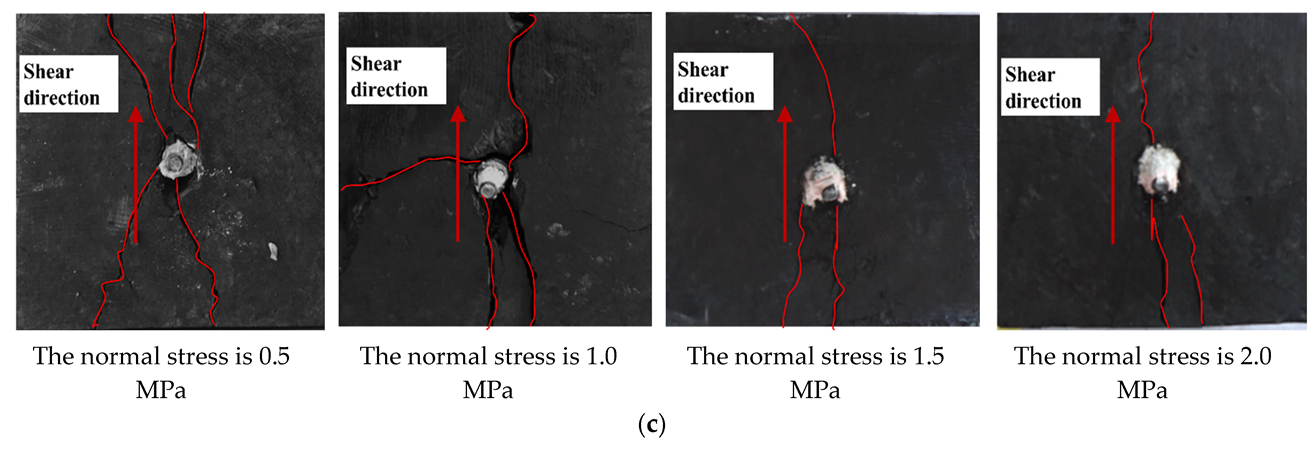
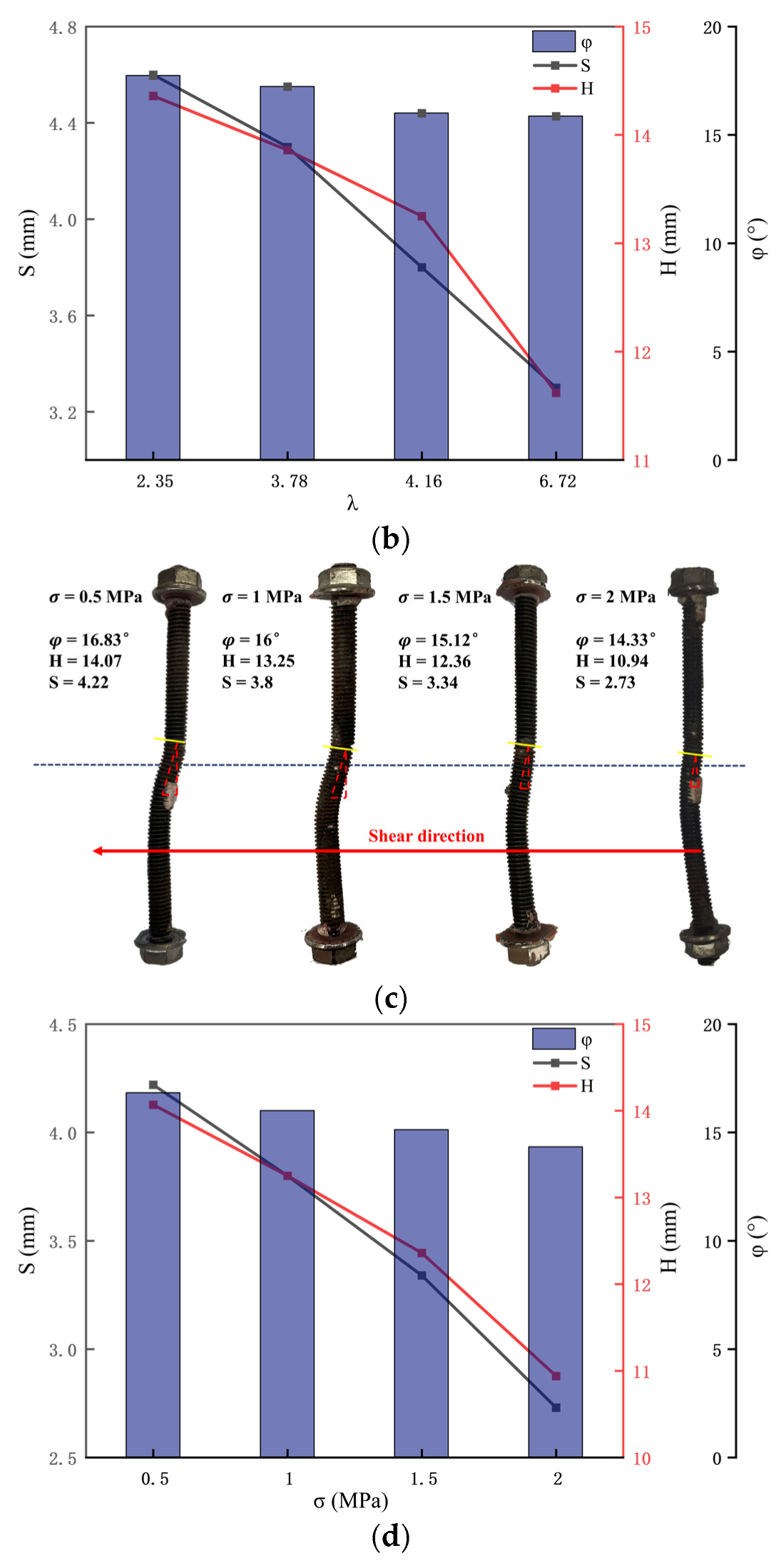




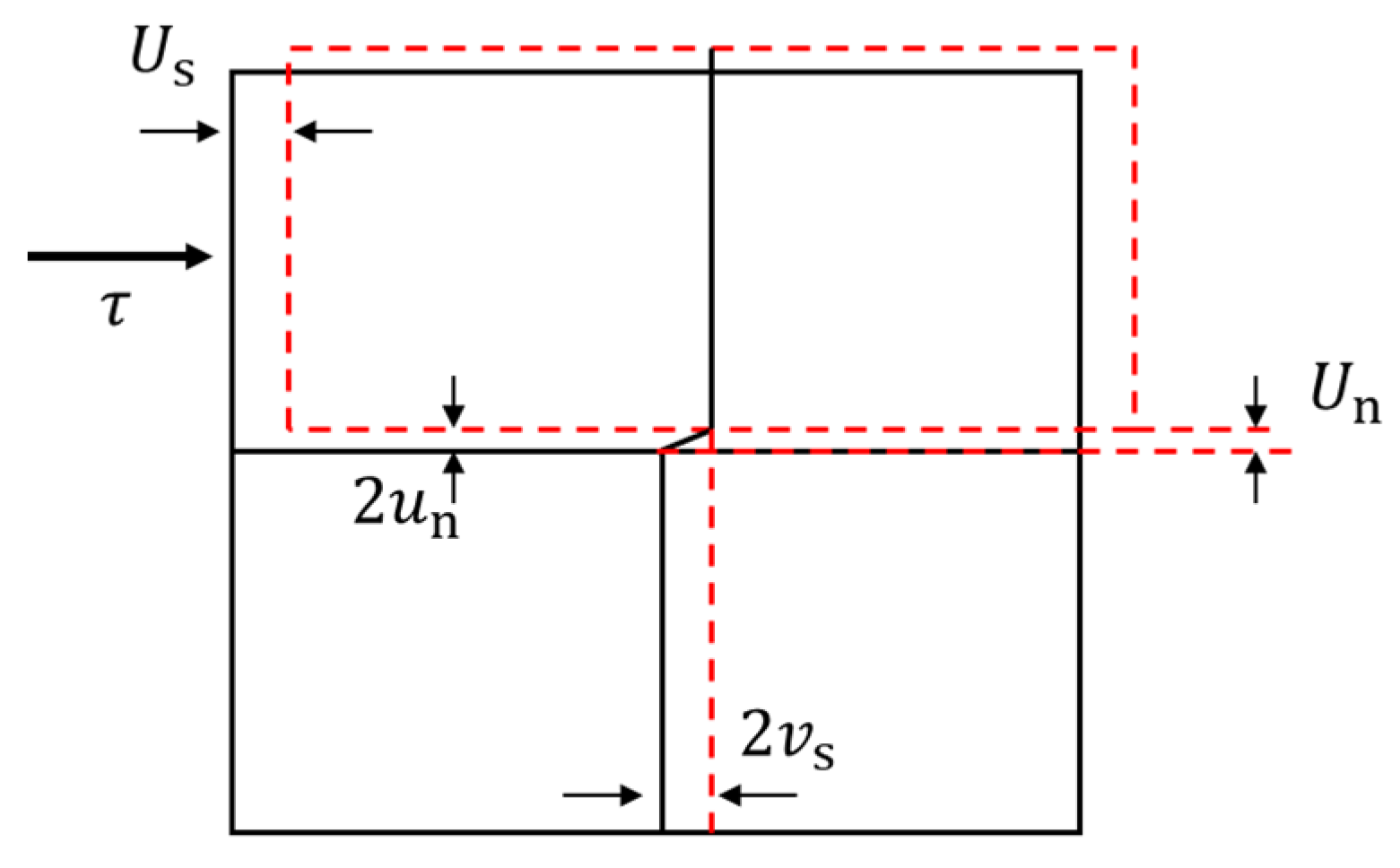

| Anchorage Agent: Planting Reinforcement Adhesive | Anchor Bolt: Carbon Steel | ||
|---|---|---|---|
| Temperature | 25 °C | Diameter | 6 mm |
| Setting time | 48 h | Length | 100 mm |
| Tensile strength | 50 MPa | Tensile strength | 800 MPa |
| Elasticity modulus | 3980 MPa | Yield strength | 640 MPa |
| Flexure strength | 76.3 MPa | Elongation | 12% |
| Elongation | 1.3% | ||
| Title | Uniaxial Compressive Strength | Tensile Strength |
|---|---|---|
| White sandstone | 86 MPa | 6.45 MPa |
| Green sandstone | 53.17 MPa | 4 MPa |
| Black sandstone | 48.33 MPa | 3.28 MPa |
| Red sandstone | 30 MPa | 2.77 MPa |
| Coal | 12.78 MPa | 1.4 MPa |
Disclaimer/Publisher’s Note: The statements, opinions and data contained in all publications are solely those of the individual author(s) and contributor(s) and not of MDPI and/or the editor(s). MDPI and/or the editor(s) disclaim responsibility for any injury to people or property resulting from any ideas, methods, instructions or products referred to in the content. |
© 2023 by the authors. Licensee MDPI, Basel, Switzerland. This article is an open access article distributed under the terms and conditions of the Creative Commons Attribution (CC BY) license (https://creativecommons.org/licenses/by/4.0/).
Share and Cite
Jiang, Y.; Li, X.; Liu, J.; Luan, H.; Zhang, S.; Wang, C.; Wang, D. Study on Shear Behavior and Failure Characteristics of Bolted Anisotropic Rock Joints. Materials 2023, 16, 2210. https://doi.org/10.3390/ma16062210
Jiang Y, Li X, Liu J, Luan H, Zhang S, Wang C, Wang D. Study on Shear Behavior and Failure Characteristics of Bolted Anisotropic Rock Joints. Materials. 2023; 16(6):2210. https://doi.org/10.3390/ma16062210
Chicago/Turabian StyleJiang, Yujing, Xinpeng Li, Jiankang Liu, Hengjie Luan, Sunhao Zhang, Changsheng Wang, and Dong Wang. 2023. "Study on Shear Behavior and Failure Characteristics of Bolted Anisotropic Rock Joints" Materials 16, no. 6: 2210. https://doi.org/10.3390/ma16062210






